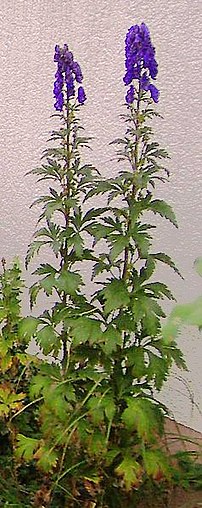[amazon_link asins=’B0087PWULC,B00PMLEUGW,4022645075,B0084MC7XY’ template=’ProductCarousel’ store=’finmeacur-20′ marketplace=’US’ link_id=’c1c39268-48f0-11e7-83c4-11f788cb396f’]
Botanical Name: Aconitum carmichaelii
Family : Ranunculaceae
Genus : Aconitum
Kingdom: Plantae
Division: Magnoliophyta
Class: Magnoliopsida
Order: Ranunculales
Species: A. carmichaelii
Synonyms; Aconitum fischeri – Forbes.&Hemsl. non Rchb. Aconitum fortunei – Hemsl.
Common Names :Autumn monkshood, Azure monkshood (Chinese:pinyin,Japanese:Torikabuto)
Habitat: It is native to East Asia, particularly in China and Japan. Growing in E. Asia – C. and W. China to N. America. It grows on the forest margins, scrub, grassy slopes and mountains at elevations of 100 – 2200 metres.Woodland Garden; Dappled Shade;
Description;
Herbaceous perennial plant growing to 1.5m by 0.3m.
It is in flower from August to September. The flowers are hermaphrodite (have both male and female organs) and are pollinated by Bees.
CLICK & SEE THE PICTURES
A handsome, spreading plant, this aconite has rich blue, hooded flowers that appear in late summer and last until autumn. The foliage is coloured rich green. It is a robust plant for the back of the border. All parts of the plant are poisonous so handle with care.
The plant prefers light (sandy), medium (loamy) and heavy (clay) soils and can grow in heavy clay soil. The plant prefers acid, neutral and basic (alkaline) soils. It can grow in semi-shade (light woodland) or no shade. It requires moist soil.
Cultivation :-
Thrives in most soils and in the light shade of trees. Grows well in heavy clay soils. Prefers a moist soil in sun or semi-shade . Plants will only thrive in a sunny position if the soil remains moist throughout the growing season . Prefers a calcareous soil. This species is not included in the Flora of North America and so it should be considered doubtful that its range includes this region. A very ornamental plant, there are some named forms.
It grows well in open woodlands. Members of this genus seem to be immune to the predations of rabbits and deer . A greedy plant, inhibiting the growth of nearby species, especially legumes. Closely related to A. fischeri and considered to be part of that species by some botanists.
Propagation:-
Seed – best sown as soon as it is ripe in a cold frame. The seed can be stratified and sown in spring but will then be slow to germinate. When large enough to handle, prick the seedlings out into individual pots and grow them on in a cold frame for their first winter. Plant them out in late spring or early summer. Division – best done in spring but it can also be done in autumn. Another report says that division is best carried out in the autumn or late winter because the plants come into growth very early in the year.
Medicinal Actions & Uses:-
Anaesthetic; Analgesic; Antiinflammatory; Antirheumatic; Cardiotonic; Vasodilator.
It is considered a medicinal herb by some and the root is most commonly used to effect circulation, restore yang and expel cold. It is sometimes used topically in Dit Da Jow liniment. If not prepared properly by a trained person, it is deadly when taken internally.
A widely used herbal remedy in China, it is cultivated for its root. This is harvested in the autumn as the plant dies down and is then dried before being used. The root is anaesthetic, analgesic, anti-inflammatory, antirheumatic, cardiotonic, stimulant and vasodilator . It is used in the treatment of shock and collapse, chronic diseases with symptoms of cold, gastralgia and rheumatic arthralgia, oedema and diarrhoea due to hypofunction of the spleen and kidney. A tincture of the root is used externally in the treatment of rheumatism, arthralgis, sprains, contusions etc. Use with great caution, the plant contains the toxic alkaloid aconitine and is very poisonous – should not be used internally unless under the direction of a qualified practitioner. Overdoses lead to numbness of the tongue, lips and extremities, nausea, vomiting, irritability and coma.
Known Hazards: The whole plant is highly toxic.
Disclaimer:The information presented herein is intended for educational purposes only. Individual results may vary, and before using any supplements, it is always advisable to consult with your own health care provider.
Resources:
http://www.pfaf.org/database/plants.php?Aconitum+carmichaelii
http://www.plantpress.com/plant-encyclopedia/plantdb.php?plant=7366
http://en.wikipedia.org/wiki/Aconitum_carmichaelii


































